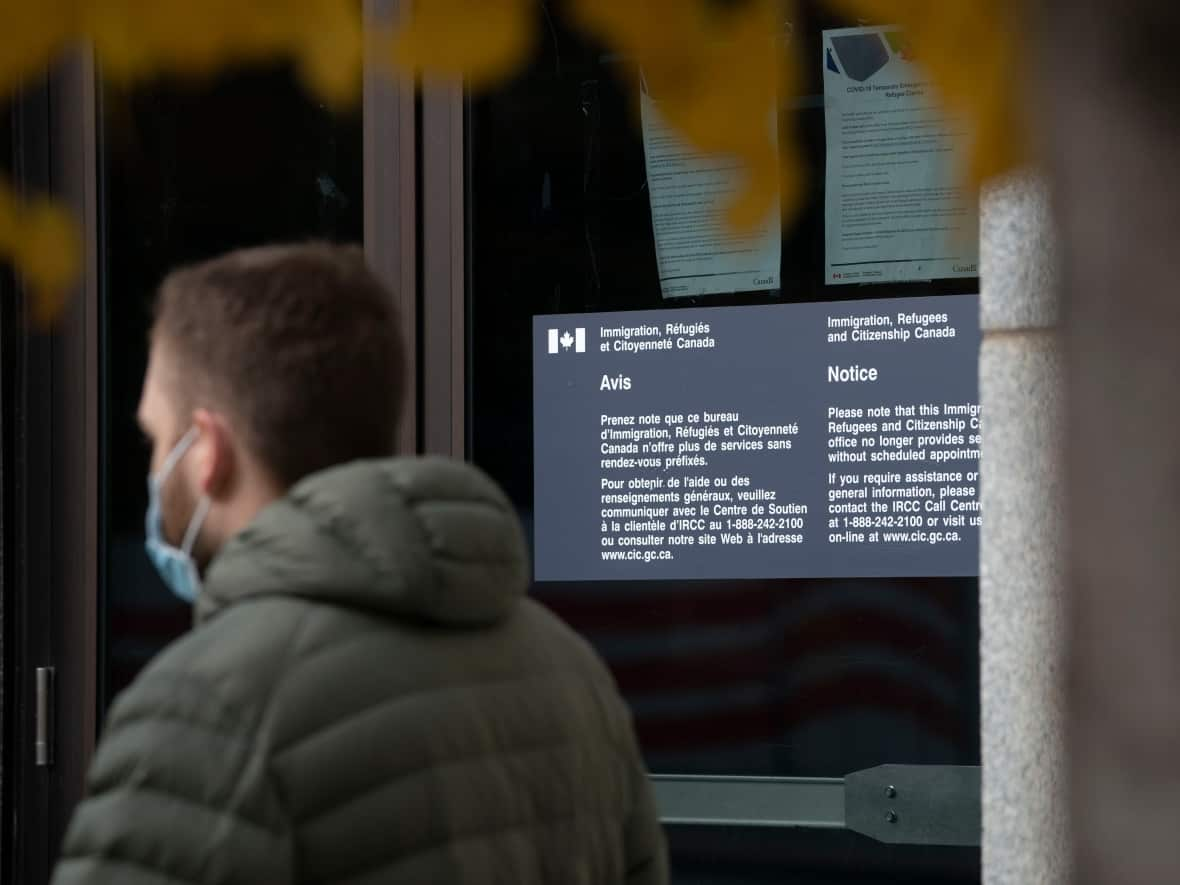Here's what happens when your immigration application is assigned to inactive employees IDs

After CBC News published a story about how Canada's immigration department assigned tens of thousands of applications to hundreds of inactive employees and placeholder codes, the department explained its processing system and why it does this.
CBC asked Immigration, Refugees, and Citizenship Canada (IRCC) for all inactive employees and placeholder codes assigned to applicants earlier this year in an Access to Information request. In October, we received data on IRCC's "inactive users" in its Global Case Management System (GCMS) — the worldwide internal system used to process citizenship and immigration applications.
The data shows 59,456 "open, pending or re-opened" applications assigned to 779 codes. This represents, as of February 2022, "a mix of former employees who are no longer active and computer placeholders" — some who last logged in and processed files 16 years ago, and some from airports and visa offices around the world.
For example, code SM10353 topped the list with 9,540 applications assigned to it. This former employee or placeholder based in Sydney, N.S., last used the system on March 23, 2021.
In the past two months, CBC has followed up with IRCC several times to understand the data it obtained.
We asked the department to explain why it assigned thousands of applications to former employees and placeholder codes and what happens to applications once that happens. The department did not answer those questions until after the story was published.
Meanwhile, Immigration Minister Sean Fraser told reporters this was an "ordinary process" and part of IRCC's "triage strategy," and ex-employees' IDs were used to hold onto applications that have similarities.
WATCH | Liberals and Conservatives spar over inactive immigration codes:
So what happens once an immigration application gets assigned to a code on IRCC's inactive users list?
In the days following the story, the department arranged a background briefing with two senior officials who understand its GCMS system. CBC agreed not to name them as they were not authorized to speak publicly on behalf of the department.
Here's what we learned.
When did the department start repurposing ex-employee codes?
IRCC employees are identified via codes, which consist of a mix of letters and numbers (AB12345, for example).
"The user code is a unique ID. Once assigned, no other user would have the same one," explained an IRCC spokesperson about the data back in November. "If a user was no longer required to use GCMS, the code would become inactive."
IRCC says its practice of repurposing former employees' IDs "became common around 2016."
Why does IRCC do this?
The department said it's unable to delete these inactive user accounts for legal reasons, and it "would lose traceability."
IRCC officials say it's easier for them to use a code that already exists within GCMS, rather than create a new one to use as placeholders for applications.
What exactly does 'placeholder' mean?
IRCC uses terms like "placeholder," "catchment area," "group reference number," and "batch code" to describe the renewed purpose of these inactive users' codes.
The terms mean the same thing: bins that hold applications in queue as they wait for the next stage of processing.
Officials compared this to the role of a mailbox at a physical office building.
Immigration officers would go in and pull files from these "mailbox" bins to work on, based on their line of business and expertise.

What happens when someone gets assigned to an inactive code?
When someone's file is assigned to these bins, it's waiting for an employee to work on it.
Let's take a permanent residency (PR) application for example, and an immigration officer goes in and grabs that file to review its security clearance.
If the file needs more information or clearance from one of IRCC's partners abroad, such as its New Delhi visa office, then the application would go back into a bin and wait for officers there to complete the step, an official explained.
WATCH | What this PR applicant thinks about being assigned to code on inactive list:
If all steps for the PR application are approved, the official said it would go into a bin again for the final touch.
Depending on whether the applicant is overseas or in Canada, the appropriate office would then pick it up from the "mailbox," and an officer would finalize the applicant's passport with a visa.
That's only one example of one type of application. Officials say more simple applications, like visitor visas, may spend less time in queues and may need fewer "touches" by officers.
There's a very good chance all applications that enter GCMS are assigned to these placeholder codes at some point during their lifetime, officials say.
How long do applications stay in these bins?
It depends on each case, but on the higher end, officials estimate applications can be assigned to these placeholder codes for months.
On the lower end, it could be hours.
What happens when an employee with active applications leaves IRCC?
When an employee holding onto active immigration applications leaves IRCC, it's up to their manager to reassign all their cases to another officer with similar skills.
If that's not done by the time their ID becomes deactivated, officials say IT employees do regular program runs to make sure anyone who hasn't logged in for a while isn't attached to open files. Officials call this a "fail safe" practice.
How many of those 779 codes were repurposed?
The senior officials didn't disclose exactly how many of the 779 inactive user codes were repurposed, but said a "vast majority" of them have been turned from former employee codes into holding bins.
Is there movement on those 59,456 files since February?
At any given time, IRCC says files are moving in and out of these placeholder bins, so numbers fluctuate daily.
As of Dec. 16, IRCC says 39,416 open applications were still associated with the same user IDs reflected in CBC's snapshot data from February.
Of that, the department says 25,951 applications were received after that February data pull.
"To be clear, these figures do not represent the same applications, as files are attributed and unattributed to these IDs every day," a spokesperson wrote via email.

Will IRCC rename placeholder codes to make it more transparent?
When an applicant looks at their GCMS note, obtained through Access to Information and Privacy (ATIP) requests, they may see the officer code they're assigned to at that time.
But those codes can belong to a real employee or a placeholder bin.
CBC asked whether IRCC plans to rename those placeholder bins to have a more transparent name, such as "security clearance queue" or "New Delhi visa office queue," to better inform applicants about the stage of the process.
Officials didn't rule that out. They said it's something the department is considering as its GCMS system matures.
But when CBC asked the department to do just that — describe the function of each of the top 14 inactive user codes on the list, with tens of thousands of applications attached to them — IRCC said it won't disclose that information because it "takes very seriously the security and integrity of its application processing."
Is this an efficient system?
Whether in the public or private sector, a lot of systems are designed with the worker in mind, not the client, explained Gerald Grant, an expert on information systems and a professor at Carleton University.
That appears to be the case for GCMS, he said.
"The main issue I see is how it's oriented," he said.
"When systems are designed with the back-end in mind, meaning those who are working with the system ... it will invariably favour the worker that is using the system and not the client for whom the system was designed."
Grant, who studies strategic uses of IT in the public sector, said "it creates this barrier we're seeing now [with transparency]."
Changing and redesigning a large-scale system like this would take a lot of time and money, he added.
"What they're doing could probably be considered efficient, apart from actually building a whole new system," said Grant. "[But they're] really, I would say, making do with the design they have."
Jamie Liew, an immigration lawyer and associate law professor at the University of Ottawa, said IRCC needs to be "a little bit more transparent so that people don't have to guess ... whether they fall through the cracks or not."
"It took an ATIP investigation to get these kinds of explanations for the public," she said.
Liew says the explanations, though they provide some clarity, are still "perplexing and puzzling." She's left with more questions as to why IRCC is processing applicants this way — placing applications in and out of placeholder bins between stages.
"It doesn't resemble a very efficient process. It creates extra layers and added steps that seem unnecessary," she said.
Applications assigned to inactive immigration officers, computer codes across Canada


